INSIGHTS: Homeschooling on Board for the College Bound Student
Author Kate Laird has sailed with her husband and children aboard their yacht SEAL since 2004, from Greenland to Antarctica to Alaska. She has home-schooled her children on board throughout their school years. Following on from her first article for INSIGHTS last year covering boat schooling ages 4 to 12, in this article Kate provides detailed information for boat schooling teenagers interested in US Colleges and/or using the US exam system for applications in other countries.
Published 3 years ago

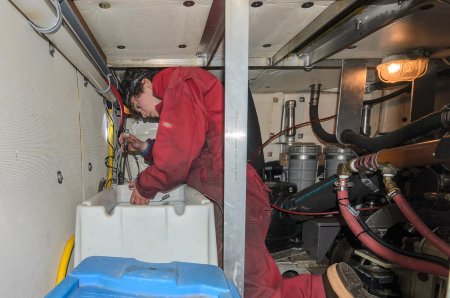
- Practical physics lessons – Anna installs a new set of batteries.
I sat down to write this article in the Fall, and then much of the advice I was going to give changed in the face of Covid 19- inspired changes to the College Admissions process. The exam systems in the US are in flux at the moment because of the difficulties of gathering large groups of students in one room. This could be great news for cruisers as companies develop online exams, or it could all revert back to in-person testing in the near future.
Standardized Test Requirements Waived
If your teenagers are applying to college this Autumn (2021 for college that begins in 2022), many US schools have waived standardized test requirements. Lucky you! For those who are a bit younger, who knows what will happen?
In this article, I will cover the basics of homeschooling for part of high school, all of high school, and preparing college applications for US colleges, including how to set up a transcript and calibrate grades. There is a lot of focus on college, because college admissions is a big factor in families deciding to give up cruising and return to shore during high school. High school is a fun time to be out sailing with the kids – they are so useful and independent! – and so I hope this will take some of the mystery and fear out of preparing your children for college-level work.
On the other hand, try not to treat high school as purely college prep.
It helped me to have an overarching idea of what we were doing year to year to tick the college admissions boxes, and then, once I was confident we were on track, I could stop thinking about it.
Internet access makes life easy
Homeschooling high school on board your boat is easy if you have internet. As we have sailed through both the Pacific and the Atlantic, internet access was generally available in major ports, but we were a much happier family when we didn’t need access, and not needing the internet freed us up to explore more remote and wonderful places. All of the resources listed in this blog are available to use offline, although some require fast internet to download materials initially. Others may require mailing materials which can be expensive, but all of the providers listed here will mail internationally.
The US Exam Schedule
In the US, high school is 9th-12th grades.
- 9th grade: Freshman year – ages 14-16
- 10th grade: Sophomore year – ages 15-17
- 11th grade: Junior year – ages 16-18
- 12th grade: Senior year – ages 17-19
If your children might want to apply to competitive colleges, it is worth considering how/where they will take exams. Many families combine exams with a flight back to the US, visiting US territories, or places with American schools.
If you want to do this and you want to limit the amount of time devoted to exams to the minimum, then you should plan this for May-June of each student’s junior year. (I’ll talk more about the exams later.)
The reason for this is US colleges judge students on completed work, not predicted grades. In many countries, students receive conditional offers based on predicted scores on end of high school exams, and if they don’t make the grades, the offer disappears. This is not true in the US. US colleges do reserve the right to rescind admissions offers, but usually that is only in extreme cases such as criminal activity or dropping out of high school.

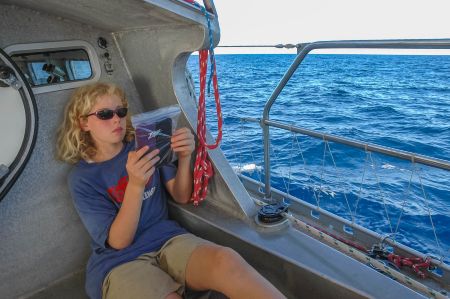
- Helen and her Kindle (in a high tech waterproof case). One of the most important parts of high school (and often skipped in bricks and mortar schools) is doing a lot of free reading.
Hybrid Approach: Boatschool & US Public School
I’ll start with the most complicated situation – boatschooling when you plan to return to a US high school after a couple of years of high school onboard. (If you are starting in a public high school and moving to the boat for the rest of high school, skip to the 100% Boatschool section, unless there is any chance your children could be returning to high school ashore.)
In most US school districts, children can move back and forth between homeschooling and public school without difficulty in Elementary and Middle School. Different states vary widely in their requirements for homeschooling legally, but as long as you have jumped through the hoops in your state, you usually have no problem.
That changes in high school. Many US districts are “all or nothing” for high school, and they will not accept homeschool credits for students who have done high school credits at home and are returning to public school.
At the worst, this means they might make a 10th or 11th grader return to 9th grade and begin all over with high school classes. There are schools that don’t have placement exams for math, for example, so it is possible that a student who had completed several years of high school math would have to return and start all over again with Algebra I. This is clearly damaging to students.
Talk to your children’s school
If you are planning to leave a school, head off on the boat for a few years, and return to the same district, the most important thing is talking to your school district and getting the answers in writing. They will generally offer one of three solutions:
- Let you homeschool (perhaps to a pre-approved plan) and return to high school in the right grade. They may offer placement exams for math and/or the chance to “challenge” end of year exams in order to earn credit. Rarely, they might include your credits on the student’s transcript, which means your student would be eligible to graduate. More commonly, they wouldn’t include homeschooling credits, but then your child would have two transcripts, one from you on the boat and one from the high school, and that would provide adequate proof for college applications. In this case, see the 100% Boatschooling section for ideas.
- Let your student follow an accredited Distance Learning Program while away, and then add those grades and credits to the transcript. In this case, the student usually returns easily into the school system, and the boatschooling period will be invisible on the college application process. This option is the most expensive and the least flexible, but it is usually favored by public schools. (In some cases, you might need to submit two separate transcripts, but as above, that is not a problem.)
- Play hardball and insist your student returns to 9th grade, no matter what you’ve done while you’re away. In this case, you could continue homeschooling for the rest of high school or look into private schools or paying tuition at nearby public schools out of your district in order to return your student to school. Private school or tuition at a public school will be more expensive than a Distance Learning Program, but it preserves your flexibility and cuts your costs while you’re away, moving the costs to when you’re back home and likely to be employed. This option is best for those who are taking a sabbatical from work and are guaranteed a job on their return.

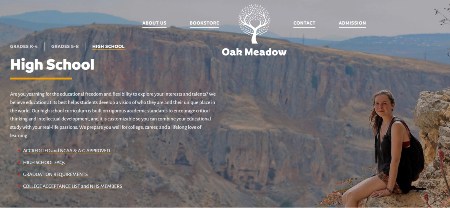
- The Oak Meadow Distance Learning Program is a good option for families boatschooling for only a year or two of high school.
Accredited Distance Learning Programs
Unless you are definitely returning to the same district and have a promise in writing that they will accept your boatschooling credits, I would recommend an Accredited Distance Learning Program. For most boatschoolers in this situation, I would go further and recommend Oak Meadow specifically.
The Oak Meadow Distance Learning Program would be about $10,000 per student for a full year of high school. There are cheaper versions that use all online classes, but Oak Meadow is the best known accredited secular program that offers full offline instruction. Students submit work samples over the internet about every two weeks, but the teachers understand the demands of ocean sailing so there is flexibility. Students can email with questions at anytime or use the internet to attend office hours with teachers.
For families that are heading off on the boat for only a couple of years, this is an excellent solution. Finding internet is always tricky when you’re cruising and so a minimal internet program like Oak Meadow will pay off in giving you more freedom to explore. It will work best if you have satellite email to communicate with your teacher and turn in assignments.
A full high school load would be full year courses in English, Math, Science, Social Studies, and 2nd Language. You might need to have the box shipped internationally which would add to the cost, but you would only need to do that once a year.
Oak Meadow does not offer advanced or AP courses, but in this case, since students would be returning to a bricks and mortar school for their last few years of high school, they would have the opportunity to take those classes in person.


- Graduation wouldn’t be complete without the cap. Anna graduates in an uninhabited anchorage.
100% Boat Schooled High School
If you are going to be on the boat for all four years of high school you have lots of freedom and lots of decisions to make! You no longer have to worry about grumpy district superintendents putting your students back into 9th grade when you return, but you do have to think about how to present the student’s work and credits to colleges.
The first thing to know is that most US colleges do not care if your student has a high school diploma. They are used to homeschooling, the Common App has a whole pathway for homeschoolers, and all colleges care about is that your student has done the work.
If you want, you can buy the cap yourself, have a gorgeous diploma made at Home School Diploma and do the whole graduation DIY. Or not. Your choice.
Oak Meadow Distance Learning Program (with teacher support)
Of course, doing a Distance Learning Program like Oak Meadow described above is an option. It takes the pressure off the parents as teachers and it is much simpler. Students graduate from Oak Meadow just like they would from any high school.
The downsides of this are the cost – $40,000 for four years of Distance Learning High School – and there are no Honors or AP level courses apart from math. I am not a fan of Saxon Math, which is the curriculum used at Oak Meadow, although it does run through Calculus, which makes it possible for students to take an AP Exam in math.
It is also possible to take Oak Meadow Distance Learning classes a la carte. This means students could do a few classes with Oak Meadow teacher support, and a few classes without. Some Oak Meadow classes are only offered to Distance Learning students and others are available for both the Homeschoolers and Distance Learners.
Homeschool Program
The Oak Meadow Homeschool program class materials are very similar to their Distance Learning Program, but there is no official transcript or teacher support.
A four subject Oak Meadow Homeschool Program costs roughly $1000 total per student. Second language studies are not available for the Homeschool program. They cost $1890 per year to do through the Distance Learning Program, or you could supplement with another language program. (You can also mix and match other classes in the Distance Learning and Homeschooling programs if you want an outside teacher in some subjects but not all.)
Many, but not all, of the Oak Meadow Homeschool programs are available as digital ebooks. This can be helpful for families looking for resources while overseas, although of course lab science boxes wouldn’t be included. This is an even cheaper option, although it does require internet access about every two weeks to confirm the rights to the ebooks, which means it won’t work on long passages or remote regions.
We never had school on short passages, but we did have “half school” on passages that lasted more than three weeks, and we have often spent far more than two weeks without internet access.
Mix and Match Homeschool Curricula
Most homeschoolers mix and match curricula, purchasing one program from one company, another from another, and creating some courses from scratch. I will list a few sample secular, offline programs later on – there are other options.
What do you need to cover? As you may remember from high school, there are many options, but the core curriculum is still math, science, English, 2nd Language, and history/social studies. Here is a list of what a few different colleges recommend as the best preparation for their applicants:

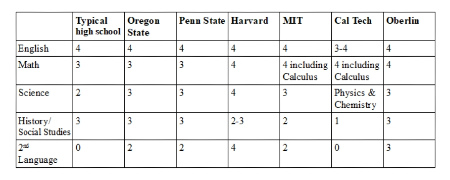
- Different colleges prioritize different high school preparations – here is a list of typical colleges and the number of years of high school study they recommend in each subject.
You can check out your state’s high school requirements here.
States care whether or not your child has done arts and physical education; colleges generally do not, although they will consider them if you put them onto the transcript.
In our family, my children did four years of English, math, science, history, and second language. Electives (more science, psychology, art history, studio art) were additional classes. As you can see from this chart, most colleges will let you cut back on 2nd languages and history/social studies, and some even math and science, but as a history major myself, cutting back on history was not negotiable!
NCAA Requirements
If you have potential college athletes, you need to be aware of NCAA competition requirements. You should sign up before you start homeschooling if there’s any chance your student will want to be a college athlete.
Levels of High School Classes
As far as homeschoolers are concerned, high school classes come in three flavors – on-level, honors, and Advanced Placement. On-level classes are taught at a typical pace, honors generally are more or less the same content, but taught more quickly and with a bit of extra enrichment. Advanced Placement (AP) level courses are meant to be taught at the first year of college level. Some can be taken with no advanced preparation, but others are better if taken after an on-level or honors course. For example, AP Biology is best taken after an earlier on-level biology course or an unusually strong middle school preparation.
International Baccalaureate
You may have also heard of International Baccalaureate courses, but at this time they are not available outside of bricks and mortar schools. Many sessile homeschooling families use Dual Enrollment at a local community college (dual meaning the student is in high school and college at the same time), but clearly that isn’t an option for families moving around on a cruising boat.

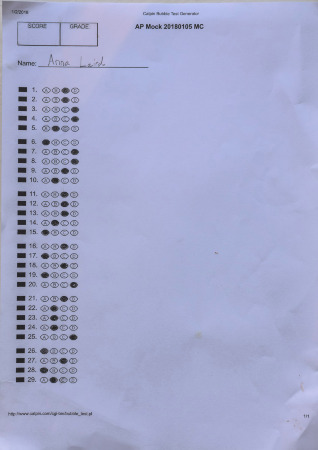
- We tried to avoid it, but sometimes school looked like this.
Advanced Placement
Official AP classes have to be sanctioned by College Board. Homeschoolers can achieve this by taking an official online course or by submitting a syllabus (an audit), and have the parent become an official AP teacher.
Note, you cannot write “AP” or “Advanced Placement” on your transcript without an official course. This doesn’t matter: colleges will understand if you simply call the course “Advanced” and provide an official AP exam score.
The real advantage of going through the process of an AP audit and becoming an official teacher is access to “AP Classroom” where there are videos, practice tests, and secured practice materials, but this will not be useful without fairly regular internet access.
AP classes by themselves are helpful, but in terms of college admissions, it is more useful to take an AP exam at the end of the course. The exams may be taken without an official course. However, at the moment, you would need to find a friendly high school to host your student for the exam. AP exams are held only once a year and are available at US high schools and often American schools in other countries. This is one place where Covid 19 could change things for the better – last year’s exams were online, this year’s are online or in person, and it is possible that online exams would be an option for homeschoolers in the future.
AP exams are sold as a way of earning college credit and saving money on college classes, but for boat schoolers living abroad the trouble of getting to the exams probably overrides any benefit of skipping college classes.
For students who want to apply to highly competitive colleges, however, AP exams are an excellent way of proving that they have followed a rigorous curriculum. If you’re thinking about this route, a visit back to the US in the May of your student’s junior year coordinated with a local school for exams could be beneficial. (Senior year exams are too late to be helpful in the college admissions process, unless your student has been waitlisted.)
Because we had intermittent internet, my children did not take official AP classes in the courses before taking the exams, except in one case. In the other cases, however, we had internet for a couple of months before the exam, and I found tutors on Wyzant.com who were AP classroom teachers. This allowed my daughters to write several practice Free Response Questions and have them graded by a professional. I could not replicate that, even in the courses I’ve done degrees in, and it was money well spent.
The deadline for signing up for an AP exam is in mid November. Signing up between November and March is possible but there’s a late fee. Exams are in May. Homeschoolers need to find a physical school with an AP Coordinator who will order and administrate their exams.


- Helen and Anna study the intertidal zone during a four week intensive biology program led by a recent graduate who traded her teaching for a cruise with us.
Big Projects
As you read through my sample materials and suggestions for course work, it will all sound very “school at home.” Our school shifted from almost unschooled, to half unschooled, to pretty much all school at home as we moved from Kindergarten to Grade 12 on board the boat.
Some people like knowing they are doing just what a typical student would be doing back home. Others don’t want that at all, and that’s why they’re off on a boat sailing the world.
We tried to balance the routine of typical high school classes (which we did with focus for about six months a year) with big projects.
Twice, we traded a month on the boat for intensive science teaching from recent graduates, one a biologist, the other a geologist. We let all other school slide during this time.

- Helen and Anna in the geology lab during a three week intensive geology program led by their geologist cousin Jack.
While I was the instigator of these learning sessions, the following activities were entirely the kids’ ideas:
One daughter pursued an intensive microplastics research project, trawling for microplastics and counting beach waste, and then wrote a 20-page paper and a poster presentation about it.

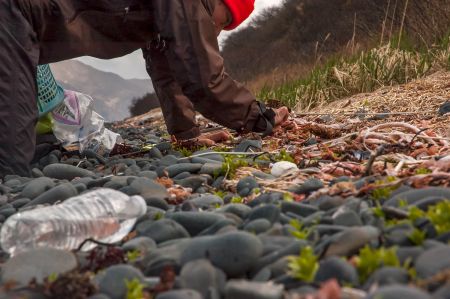
- Helen surveying microplastics for her junior project.
The other daughter spent a month digging through old newspaper articles and wrote a 10-page history paper from her research.
When Covid hit, one daughter had “health” on her transcript. We shelved her health book, and she researched Covid 19, and wrote and illustrated a 20-page book for local kids about mask wearing, hand-washing, and Covid transmission.

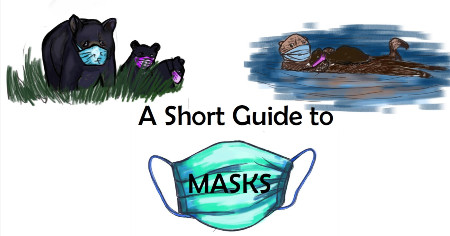
- Anna wrote and illustrated a guide to wearing masks for local children. As far as she was concerned, this had nothing to do with school, but I had no problem in using it to tick the “health” box
In early high school, one daughter wrote a short novel, illustrated it, and published it for the family.
One of the great things about homeschooling is you can shuffle the school year around to make room for student-led projects, which are probably the things they are going to remember in 20 years’ time, anyway.
Writing a Transcript
If you’re boatschooling on your own without a Distance Learning Program, you’ll need to keep track of courses on a transcript. This really isn’t as dramatic or difficult as it sounds. A transcript should look like what colleges are used to seeing, even if your student has followed a non-conventional type of program. For example, I assigned about four books a year for literature, but my kids would read 20-30 other books during the year. I “counted” those 20-30 as part of school, even though the kids didn’t.
If you are making courses yourself, you can either just use numbers (English 1, English 2, English 3, English 4) or use specific titles (Freshman English, American Literature, World Literature, Composition).
US Colleges expect to see transcripts reported in Carnegie Units. This sounds very grand, but basically 1 Carnegie unit is a full year class (such as Algebra I), and 0.5 Carnegie units is a semester course (such as Studio Art.) The expectation is that a semester’s class will be about 60 – 75 hours of class time, plus about 40 hours of homework. This counts as 0.5 Carnegie units. For classes that can be recorded with a log such as life skills, art or PE, 90 hours is 0.5 Carnegie units.
I have a GPA calculator / transcript writer in a spreadsheet that you can use. It includes a sample student entry, so you can see what it would be like. Fill out the transcript and either print directly, or cut and paste it into a document so you can make it prettier.
SAT and ACT
In non-Covid years, most colleges require the SAT or ACT. Some “test optional” schools required testing from homeschoolers. In non-Covid years, these are available at several times during the year, and at international locations as well as US locations.
You can search for testing sites for the SAT here.
You can search for testing sites for the ACT here – US States and territories.
You can search for testing sites for the ACT here – International
Most US Colleges accept either the ACT or the SAT at this time. The best way to choose is to have your student take a timed practice test (using official materials rather than a test prep book) in each and see which they do better with.
The ACT is slightly faster paced and has more subject-matter testing.
The ACT has an entire section devoted to science and a separate science score. (Having a science score may be useful for homeschoolers, particularly those without science AP scores.)
The ACT has more geometry; the SAT has more trigonometry.
The SAT weighs math twice as heavily.
The test prep site Prep Scholar has a good article breaking down the details. – we did not use their test prep courses, but their blog is a valuable source of information, particular for students aiming for very competitive colleges.

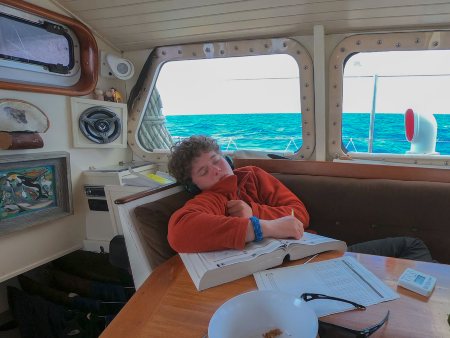
- Studying for SATs was not the most intellectually engrossing task, but it paid off.
Practice
Whether your students chose the SAT or the ACT, they should practice. Khan Academy has free testing materials, and you can also buy paper practice workbooks. (Paper is the best if your student is going to be taking exams on paper rather than online.) These tests are *not* intelligence tests – they are tests of how hard your student is willing to work to prepare for them. Preparation can be done at no or little cost with materials downloaded from the examiners or Khan Academy. Students who put in 40-plus hours of prep time can raise their scores considerably.
Students who score over 1400 on the SAT or over 32 on the ACT are likely to receive merit scholarships from all but the most competitive private colleges. (Highly competitive private colleges rarely offer merit aid – instead they tend to offer generous financial aid based on the family’s income and assets.)
Other SAT/ACT Practice Material
Part of me raged over the time and effort that went into test prep. I remember my advice to my kids when they went off to the exam: Do Not Engage. It was the absolute opposite of the approach we had taken towards every subject. In the SAT/ACT if you don’t know how to do a problem in a second, you should skip it. In our coursework, puzzling out answers was what it was all about.
It helped us to think of the SAT/ACT as a test of how badly they wanted to go to a good college, rather than an academic test. It is an exam that rewards practicing on it, and better scores can mean merit aid and improved chances of admission.
My children took the SAT, so we haven’t personally tried the ACT versions listed.
- SAT Prep Black Book: The Most Effective SAT Strategies Ever Published 2nd Edition – by Mike Barrett and Patrick Barrett
- ACT Prep Black Book: The Most Effective ACT Strategies Ever Published 2nd Edition – by Mike Barrett and Patrick Barrett
- Math resources from Nielson Phu, College Panda: https://thecollegepanda.com/
- Reading and Writing resources from Erica Meltzer: https://thecriticalreader.com/books/
- Official practice tests: https://collegereadiness.collegeboard.org/sat/practice/full-length-practice-tests and https://www.act.org/content/act/en/products-and-services/the-act/test-preparation/free-act-test-prep.html.
College Level Examination Program (CLEP)
The College Board also offers the CLEP exam – College Level Examination Program. There are 34 different exams, which can be used to calibrate homeschool grades and demonstrate the rigor of the homeschool program, even at schools that don’t accept CLEP scores for credit or placement.
When my children were applying for college two and three years ago, it was seen as very helpful to calibrate homeschool grades with AP scores and SAT subject test scores. The College Board has just eliminated the SAT subject tests, which tested honors level attainment in a huge variety of courses. I suspect they may bring back the language tests or the SAT subject in some other form in the near future, but until that time, CLEP could be used in the same way.
AP Exams
AP Exams are a superb way to calibrate grades for students who are doing a rigorous program. Colleges will consider scores from 9th-11th grade in students’ applications. Students do not need to take an official AP class, but they do need to find an accommodating high school where they can take the exams.
These exams are much more like a typical three hour college exam, and reward the same preparation. The most important preparation is a thorough course of study. A study guide is helpful – different publishers excel in different subjects, so it’s worth doing some research to get the best one.
Doing an official course or working with an official teacher as a tutor provides access to official practice materials.

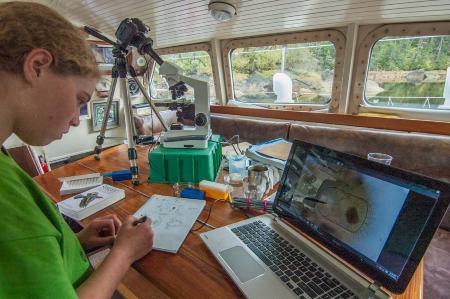
- Helen observes plankton – we’ve set up a camera with the microscope in order to be able to use the computer screen for viewing. You can also buy microscopes that already do this, but if you already own the camera, you can use that instead.
High School Resources
Secular Homeschooling Mix & Match Options
Science
On-level/Honors
9th and 10th grade options:
Real Science Odyssey from Pandia Press has two courses that are suitable for grades 6 – 10th, Biology 2 and Astronomy 2. Both would be excellent courses to teach on board the boat – particularly Astronomy. Some of the biology labs might be hard to do, depending on where you are. You can download the materials or buy paperbacks here.
Conceptual Academy is an excellent resource for on-level and honors high school science. The full courses requires internet access to watch the videos, but paying for the courses does give you access to downloadable pacing guides, solution manuals, and worksheets, so it is probably worth it even if you are not going to be able to watch the videos. You need to purchase the textbooks separately [https://learnscience.academy/]. They have two lab options – using resources at home (some of which may be hard to come by onboard) or buying dedicated lab kits which will need to be mailed to you.
Oak Meadow: on-level science options
Build Your Library is a multi-disciplinary program that covers English, history, and science. (Science is not included in the Grade 12 curriculum.)
You purchase the curriculum guide from Build Your Library, and then purchase all the books and lab kits separately.
The Crash Course lectures in Anatomy, Astronomy, Biology, Chemistry, Computer Science, Ecology, Engineering, Physics, and Statisics. All are downloadable for use offline.

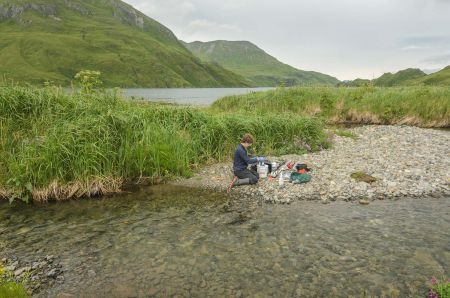
- Anna tests the water using fish tank testing materials for AP Environmental Science
Advanced/AP – Environmental Science
If you’re trying to do offline AP level science, the easiest one to do is Environmental Science. It is a fabulous course, and everyone should take it! It is particularly appropriate to do on the boat.
You’ll need a textbook (we used Withgott, Environment: The Science Behind the Stories), a video component (we used Bozeman – http://www.bozemanscience.com/ap-es-001-environmental-science – view them on Youtube to download them), and a lab component. We used the resources from https://teachingapscience.com/ to develop the labs. The biology kit from thehomescientist.com would be useful for labs, too. The BioZone workbook Environmental Science was a useful addition.
Environmental science will be easier if a student has already done on-level chemistry and biology, but it is not required.
For a list of AP level textbooks and a sample syllabus see https://apcentral.collegeboard.org/courses/ap-environmental-science/course-audit
Biology
We used Biology in Focus for AP as the textbook, Thinkwell Biology (we bought the extra DVDs) for the video component – this was okay, but didn’t work that well without internet access, and QSL Advanced Biology for the lab kit. If I were doing it again, I would use Bozeman for the lectures: http://www.bozemanscience.com/ap-biology
For a list of AP level textbooks and a sample syllabus see https://apcentral.collegeboard.org/courses/ap-biology/course-audit
Chemistry
We had internet access the year Helen did AP Chemistry, so she used Thinkwell, but if I were doing it without internet I would use Bozeman videos: http://www.bozemanscience.com/ap-chemistry; Zumdahl Chemistry with the Student Solution manual; QSL Advanced Chemistry Labs. (We did use these labs).
For a list of AP level textbooks and a sample syllabus see https://apcentral.collegeboard.org/courses/ap-chemistry/course-audit
Physics
My children did not study physics at the AP level. QSL has a standard physics level which we used for an onlevel course, and it is probably the best possible option for AP in the home market. (QSL also sells AP kits for the Johns Hopkins Center for Talented Youth online classes, but as they don’t come with manuals, it’s better to use the standard physics kit.)
There are four AP physics exams, Physics 1 (Algebra-based); Physics 2 (Algebra-based); Physics C: Electricity and Magnetism (Calculus-based); Physics C: Mechanics (Calculus-based).
Bozeman provides lectures for the two algebra-based courses.
Openstax has a free AP textbook: https://openstax.org/details/books/college-physics-ap-courses or look for one of the college textbooks on the College Board list that has student solution manuals for purchase: https://apcentral.collegeboard.org/courses/ap-physics-1/course-audit.
Solution Manuals
Note that high school textbooks almost never have readily available student solution manuals, but college level textbooks (often the same book without AP written on it!) frequently do. Solution manuals are a great step up from the answers to the odd problems at the back of the book, as they include step by step solutions which are great to help students figure out where they’ve gone wrong.

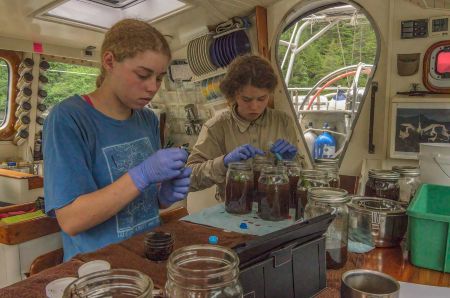
- Helen and Anna build microcosms for biology lab following instructions from the Home Scientist Lab Kit.
Science Lab Materials
QSL Labs: Quality Science Labs produce all in one boxes of materials. These kits and lab manuals are terrific, and will provide everything you need for a solid high school lab experience in the box. Highly recommended (ships to the US and internationally).
The Home Scientist: These lab kits are more comprehensive and professional than the QSL Lab kits, but the manuals are not as precise. These are terrific kits for sciencey kids who want to have equipment to explore on their own. Highly recommended, but not for the science averse (ships to the US and internationally).
English
Brave Writer
https://store.bravewriter.com/collections/bundles/products/high-school-writers-bundle is a thorough writing program for high school. Combine this with a heavy diet of free reading and the occasional literature paper (every month or two) for a complete curriculum. SAT or ACT prep materials can be used for grammar review.

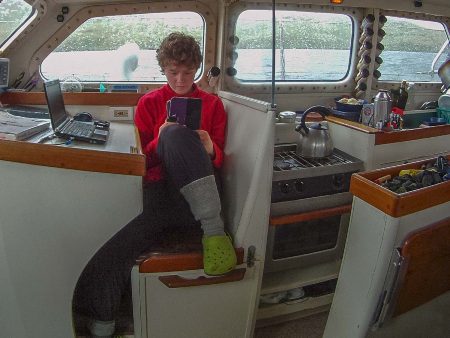
- Anna and her Kindle.
Laura Randazzo
Laura Randazzo on Teachers Pay Teachers is marvelous for teaching English. She sells individual packets or you can buy an entire curriculum for 9th or 10th grade, which could easily be spread out over three or four years, if you added in a good load of free reading and essay writing. Originally, all her presentations were in Prezi, but she is nearly finished upgrading each course to Prezi, Google Slides, and PDF slides – the PDFs are great for using when you don’t have internet (you do need the internet to download the class.) If you buy a class, you will have access to any upgrades she makes. If you want to try before you buy, you can buy a couple of courses, and if you decide that you want to buy the complete curriculum within a year, you can request a refund on any courses you have purchased earlier.
https://www.teacherspayteachers.com/Store/Laura-Randazzo or directly to the full curriculum bundle: https://www.teacherspayteachers.com/Product/Full-Year-High-School-English-180-Days-of-English-9-10-Curriculum-CCSS-3735671
Oak Meadow
https://www.oakmeadowbookstore.com/high-school-english/
Build Your Library
Build Your Library is a multi-disciplinary program that covers English, history, and science.
You purchase the curriculum guide from Build Your Library, and then purchase all the books and lab kits separately.
High School Math Offline Options
US Math Sequence
If you are not familiar with the traditional US math sequence, here is a brief summary.
The Common Core is a widely accepted list of what is to be learned when in US math (contrary to many homeschool and parenting sites and blogs, it is not a technique or system – it is merely a skills list.)
High school math presented a particular problem because there are two styles of math, integrated (what most of the world uses) and US traditional (breaking it down into subjects, usually taught in the order of Algebra 1, Geometry, Algebra 2 and Trig, Precalculus, Calculus.) To further complicate matters, about half of the country starts “high school math” in 8th grade (which is when the rest of the world begins it) and half the country starts it in 9th grade.
In order to be competitive for highly selective colleges, most students need to take some Calculus in high school, even if they don’t finish the entire “first year college Calculus” cycle. This is not a complete deal breaker, particularly for kids outside the school system. Every highly selective college has several sections of Calculus for freshmen who haven’t completed it or who don’t score high enough on the AP or university placement tests.
In order to take Calculus in high school, the high school math sequence needs to be begun in 8th grade.
Some students will be ready to begin in 7th grade.
Some students may be finished with Elementary/Middle School math, yet struggle with high school math. This may be a maturity issue – Algebra is more conceptual than Prealgebra, and it can be a difficult transition for many students, who would benefit from waiting a bit, or spreading Algebra 1 over two school years.
A Few Sample Programs

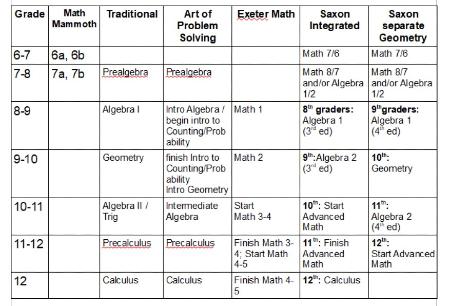
- Different Options for High School Math.
Roughly half of American students are in the earlier of the two grades listed, half in the later grade. A small number of students are ready to begin a year earlier than the lower one listed here. Beginning the “high school math” sequence in sixth grade or earlier is very unusual.
Middle School Math
If you are looking for a solid middle school program to get ready for high school math or fill in any gaps, I recommend Math Mammoth. Level 7 is actually the standard US 8th grade math, aka Prealgebra. You can buy the program as PDFs, as paperbacks, and a combination (paperback workbooks and PDF solutions, tests, etc.).
Dyslexic students may struggle with Math Mammoth as there is very little white space on the page. Singapore Math is better laid out, and we used it with great success from grades 1-6, but the 7th grade Dimensions program was not as good as the earlier Primary Math. (It wasn’t terrible, either, but just not the quality level we’d come to expect.)
Videos (click through to Youtube in order to download them)
Khan Academy
Khan Academy – you can download Khan Academy and use it on a local server. Many people use Khan as their sole curriculum, but I don’t think it’s enough. It is incredibly useful as a supplement or explainer. See Kolibri (formerly KA Lite) https://learningequality.org/kolibri/ to set up the server.
Exeter Math
If you like math and don’t mind doing it alongside your students, you can’t do better than Exeter Math. The problem sets are free PDFs, but alas there is no answer key. You need the PDFs, notebooks, a graphing calculator (we used a TI 84 Plus CE – color), and it is useful to have a downloaded version of Khan Academy: https://www.exeter.edu/mathproblems
Art of Problem Solving
If your students like math and puzzles, The Art of Problem Solving sells paperback textbooks and solution manuals. This is a bit of a love it or hate it curriculum. It is amazing for mathy kids, but it can be too much for others. Like Exeter Math, it is hard to help students with this curriculum without doing it alongside them unless you are a math wizard.
OpenStax
OpenStax textbooks & instructor resources – you will need some sort of proof you are homeschooling in order to set up an instructor account, but a homechool (or boat) website/blog is enough. The textbooks are free as PDFs and can be purchased for the cost of printing if you want a paperback.
Math Without Borders
(downloadable, but very large files – Algebra 1, chapter 1 is 187 mb.).
The teacher component to go with some of the best high school math textbooks. You need to purchase the math books separately. Algebra 1: Expressions, Equations, and Applications, by Paul A. Foerster; Geometry-A Guided Inquiry, by G. D. Chakerian, Calvin D. Crabill, and Sherman K. Stein; Algebra and Trigonometry: Functions and Applications, by Paul A. Foerster; Precalculus with Trigonometry: Concepts and Applications, by Paul A. Foerster; Companion to Calculus Concepts and Applications, by Paul A. Foerster.
Saxon Math
This is a bit of an old fashioned option, and my least favorite of the ones listed, but it is the most homeschool friendly. You can buy the books from the publisher, Oak Meadow, Amazon, or a variety of homeschool vendors. Available with solution manuals, tests, etc. – a complete homeschool package which makes it easy for parents. Many students find Saxon to be tiresome, as there is a lot of built in review.
My uneasiness with the program is that it is very algorithm-based. Students learn to apply techniques to problems rather than develop deep conceptual understanding and problem solving skills. More on this from Maria Miller, author of Math Mammoth:
We used the test books from Saxon to calibrate work done in Exeter Math, and in the proofs, the answer key said things like “by theorem 11,” but of course, there is no theorem 11 outside the Saxon universe. I didn’t like the memorization that implied – it is better if students can articulate the actual geometric ideas.
One of the good things about Saxon is its multiple paths in beginning high school math. Some students are ready to make the transition to Algebra early, some are not, and it is usually a question of mental maturity not mathematical ability. Students can do Math 8/7 or Algebra ½ or both, as needed.
Students continuing with Saxon high school math from Saxon should look at the last 5 tests in book 7/6. Students who score above an 85% on the last five tests are ready to go straight to Algebra ½. Students who don’t reach that level should go to book 8/7.
At the end of 8/7, again, look at the last five tests. Students who score better than 85% should jump to Algebra 1. Students who don’t should go to Algebra ½.
Once a student is ready to begin Algebra 1, either because they did very well in 8/7 or they have finished Algebra ½, the next step is to decide which high school pathway to use. Students beginning Algebra 1 in 8th grade normally go to Saxon’s traditional sequence, beginning with Algebra 1 (3rd edition). Students beginning Algebra 1 in 9th grade or later should use Algebra 1 (4th edition) and do the separate year of Geometry, in order to have adequate geometry in time for the SAT / ACT in 11th grade.
For students coming to Saxon for a different Elementary School/Middle School program, be sure that they take Saxon placement tests.

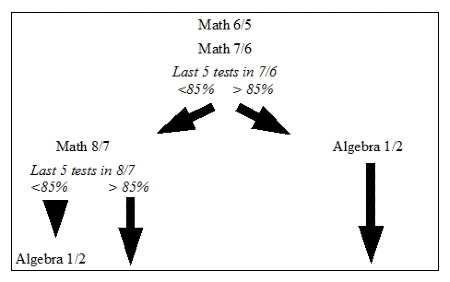
- Decision Chart for Saxon Algebra.

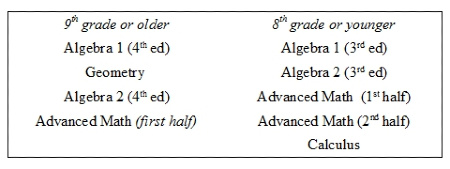
- High School Math Paths for Saxon
You can purchase directly from the publisher – be sure to buy the kit with the Solutions Manual.


- History comes to life in the Aleutian Islands with a crashed B-24 Liberator.
History
We studied history with three years of World History and a year of US history. The World History AP exam is now all post 1200 CE, so this system would work even better.
We used the Great Courses history lectures as the video portion. These are available to download or as DVDs. They are hideously expensive, but if you watch the sales, everything comes on sale sooner or later.
History of the Ancient World: A Global Perspective (Aldrete)
The Barbarian Empires of the Steppes (Harl)
This course is an interesting take on the intersection of Asian and European history, transcontinental trade, and of course the Mongols. We ended up using it for our entire World History II course, and then caught up with the other regions in World History III.
A Brief History of the World (Stearns)
History of the United States (Guelzo, Gallagher, Allitt)
(This was not a particular favorite, but it was offline and comprehensive.)
Textbooks: We used Strayer and Nelson, Ways of the World and Shi and Tindall, America: A Narrative History.
Supplementary Monographs – we used a lot of different books, most suggested from the Great Courses Course Guidebooks. US History in particular is whitewashed, and even the best textbooks need supplementation, especially on Native American history. I recommend Mann, 1491 and Dunbar-Ortiz, An Indigenous Peoples’ History of the United States.
In general, I like OpenStax, but be warned that their American government textbook, Life, Liberty and the Pursuit of Happiness is sponsored by the extreme-right Bill of Rights Institute. You’ll notice that in most of their textbooks, the authors are listed with the universities they teach at. That is not the case with this book! I liked Barbour, Christine and Gerald Wright. Keeping the Republic: Power and Citizenship in American Politics for US government (which I taught as part of US history, but is often treated to a course of its own.)
To synthesize the information in the videos and the reading, students should write a history paper about once a month.
Other Sources of offline History Curriculum
Oak Meadow has a good history series here.
Build Your Library is a multi-disciplinary program that covers English, history, and science.
You purchase the curriculum guide from Build Your Library, and then purchase all the books and lab kits separately.
Pandia Press has Ancient History and Medieval History on offer here.
The Crash Course has downloadable video lectures in Big History, Economics, European History, Government, History of Science, Philosophy, Psychology, Sociology, US History, World History, and World History II.
World History for Us All has a lot of resources that can be downloaded:
Openstax has a US History Book available for free download.
For a list of AP-level textbooks and a sample syllabus, see https://apcentral.collegeboard.org/courses/ap-united-states-history/course-audit and https://apcentral.collegeboard.org/courses/ap-world-history/course-audit
Second Language
The easiest way to study a second language is to enroll in school locally.
The second easiest way is if one or both parents is fluent in the language.
The third easiest way is to find an online class with flexibility in attendance. This is what we did – I found a tutor on Wyzant who guided them through a standard high school curriculum. When we didn’t have internet, they wrote papers, and when we did, they had video calls.
Programs such as Rosetta Stone will provide vocabulary building, but not the direct interaction with a fluent speaker. It would be worth doing if you have no other choices, but it is unlikely to develop the fluency for students to be able to pass college placement tests.
Check out Fluent Forever for some good tips on learning second languages and vocabulary building apps.
Open Culture has many links to free resources, many of which can be downloaded and used offline.
Applying to US Colleges
Read
https://www.fairopportunityproject.org/ is the best handbook for applying to colleges – and it’s a free PDF download. (Note – I downloaded it today, and it still includes information about the SAT II / SAT Subject tests which no longer exist. Just use CLEP where it recommends SAT II.)
For students considering very competitive colleges, look through the Prep Scholar Blog.
The Fiske Guide to Colleges is an enormous paperback tome listing over 300 US Colleges, their admissions requirements, and quizzes for students to help figure out where they should apply. It is a great resource for those with marginal internet, and it is just the right height to lift a laptop for better movie viewing at the saloon table.
High School Diplomas
Most American colleges do not care if students have a high school diploma. A small number may ask homeschoolers to provide a GED (General Educational Development) Exam to demonstrate readiness, but they really shouldn’t. (A GED is a way of demonstrating competence for people who have not finished high school, but as homeschooling is legal in all 50 states, a homeschool diploma is a diploma.) Some families have been successful in challenging requests for a GED. On the other hand, it can be a good option for families who choose not to follow their state’s requirements for homeschooling.
State Regulations for Homeschoolers
Most private colleges are not interested in whether or not you have met your state’s requirements for homeschooling. State universities are more likely to care. You may find it useful to register as a homeschooler in the state where you intend to return or where you file taxes / keep up your driver’s license, if you do these things. Some states have lots of requirements, some have none.
In order to qualify for Federal Pell Grants for financial aid, students need to have followed their state’s rules for homeschooling.
Note that some state university systems have physical residency requirements in order to qualify for in-state tuition. (The University of California system is particularly strict.)
The Common App
The Common App is the most-used college application form – students upload their information, essays, and invite teachers as recommenders. As the homeschool parent, you will sign up as a counselor.
The Common App has a special section for homeschoolers. If you have done a hybrid homeschool/public school it may be best to apply as a homeschooler. You can submit an official, signed transcript from the public school (you can upload multiple transcripts for a single student). Applying as a homeschooler will give you three sections of 1000-words each to explain what you have done in your homeschool and your travels.
Recommendations
Your student will need letters of recommendations from at least one non-family member. Start thinking about this early.
- In-person teachers
- Online teachers
- Coaches/theater directors/art teachers
- Adults who have seen your kids interact with other kids
Conclusion
So, we went through four years of preparing for college, and what happened? Helen reappeared on board the boat for her spring term of her first year, trying to attend college through weak cell phone internet! (She loved being back in the wilderness on board the boat, but the internet access was so difficult she ended up living ashore for her next Covid term.)
When I asked her what we should have done differently, she immediately replied: vacations. We were very tight on time with our charter season, and in her summer vacations she worked full time as charter boat crew and did research for her science projects. As a result, she said, there was never a moment when she wasn’t thinking about school. Now, in college, she gets a couple of weeks between terms that are absolute downtime. “That would have been a help!”
……………………………………………………………………………………………………………………………………..
About the Author


……………………………………………………………………………………………………………………………………..
Related Links:
- INSIGHTS: Boatschooling ages 4 to 12.
- Homeschool Teacher: A practical guide to inspiring academic excellence – by Kate Laird
- More Insights can be found here.
- Cruising with Children – Noonsite page
- Family adventure: How we home-schooled our kids while sailing across the Pacific (Yachting World – September 17, 2020)
- Maybe the Best Home School Is … on a Boat? (NY Times – Sep, 2020)
……………………………………………………………………………………………………………………………………..
The opinions expressed in this article are the author’s own and do not reflect the view of Noonsite.com or World Cruising Club.
Related to the following Cruising Resources: Insights





